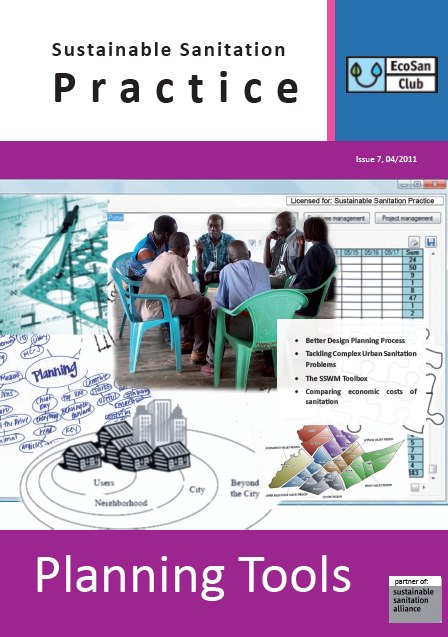
Published in: 2011
Publisher:
Sustainable Sanitation Practice (SSP), Issue 7. EcoSan Club, Austria
Author:
Ecosan Club (ed.)
Uploaded by:
SuSanA secretariat
Partner profile:
common upload
5601 Views
87 Downloads
Content - Summary
It is generally assumed that an appropriate planning process is important for sustainable implementation of sanitation solutions. Therefore, a number of projects and institutions have been and are currently working on frameworks and tools for sanitation planning. Issue 7 of Sustainable Sanitation Practice (SSP) on „Planning tools“ highlights some of the on-going work (we do not have the aim to provide a complete overview). The editors define „planning tools“ as tools that are used along the overall planning process/framework. However, the issue on „planning tools“ also includes planning processes/frameworks.
Issue 7 contains the following articles:
Towards better design of the process of planning for sanitation
McConville, J.
The provision of sanitation services is more than just technical solutions, but closely connected to the cultural and capacity of the society in which it is implemented. Given that the general opinion in the sanitation sector is that largescale sustainable results are lacking on the ground, there is a need to start questioning how planning is done today and how it can be done better. This paper presents key entry points for understanding the process of sanitation planning by highlighting options for how it should be done (procedural planning theory), who to involve (participation), and criteria for decision-making. By focusing on these key aspects of planning, the process can be adapted to meet the needs of the local context. In the future sustainable urban sanitation will start with a specifically designed planning process that uses
a mixture of planning modes and technical systems to meet the needs of diverse populations.
++++++++
Sanitation21 - a strategic approach for tackling complex urban sanitation problems
Parkinson, J., Saywell, D.
The paper presents a planning framework developed by the International Water Association (IWA) to be used by local authorities to systematically address the complexity of urban sanitation problems and develop a strategic response to these problems. The framework encourages the development of plans that are grounded within the context of the local environment. Evidently, sanitation technologies need to be compatible with the physical environment; but equally important is the need to ensure that proposed sanitation improvements are also compatible with the social and institutional context. The authors focus on the importance of a developing a comprehensive assessment of the capacities of the relevant institutions in terms of their organisational structures, human resources and interrelationships. They also focus on the need to develop a coherent policy for urban sanitation and the need for organisational strengthening to support the development and implementation of sanitation plans.
++++++++
Planning water and sanitation interventions with the SSWM toolbox
Conradin, K., Peters, D., Spuhler, D.
This article presents the Planning and Process Tools section of the Sustainable Sanitation and Water Management (SSWM) Toolbox and shows how it can be used for a more holistic planning and implementation of water and sanitation interventions. The Planning and Process tools section provides the reader with a thorough overview on the most important existing programming and planning frameworks and field-tested approaches, allowing him or her to find and apply the approaches fitting best to his case. At the same time, the Toolbox also describes various tools for each single planning step individually, so they can be mixed and matched together as needed for the intervention. Furthermore, the SSWM Toolbox as a whole supports users to move from the planning process to implementation by linking the Planning and Process section to an equivalent section on Software or Hardware Implementation Tools, thereby contributing to the overall awareness on sustainable sanitation approaches as well as their practical implementation.
++++++++
A tool for comparing economic costs of differnet sanitation options
Lechner, M.
A number of projects in developing countries have been or are developing planning tools based on the assumption that an appropriate planning process is vital for successful implementation of sanitation solutions. However, it should be taken into consideration that planning tools do not necessarily have to be developed from scratch. One could make use of successfully applied tools from other countries. Therefore the aim of this paper is to present a planning tool which is used by planners in Austria for the comparison of different sanitation options. The use of this tool, which is provided by the government, is mandatory to receive subsidies from the government for the construction of sanitation infrastructure. Different variants are compared based on their economic costs within a fixed set of framework conditions. Based on the principle that the solution having the lowest economic costs is the most favourable, this solution is eligible for receiving subsidies. To guarantee a standardised procedure a number of input variables, e.g. unit costs for investment and operation and maintenance, are fixed and can not be chosen freely by the planner. Strength and weaknesses of the tool towards its wider application are discussed.
Bibliographic information
Ecosan Club (ed.) (2011). Planning Tools. Sustainable Sanitation Practice (SSP), Issue 7. EcoSan Club, Austria
Filter tags
Cities (WG6) English Sub-Saharan Africa















